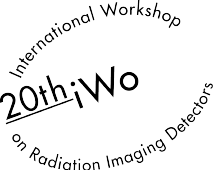Speaker
Description
ABSTRACT
Generally, nuclear material monitoring in container security uses He-3 to measure neutrons generated from nuclear materials. But due to the decrease in the supply of He-3, the development of nuclear material monitors using alternative materials has been performed[1]. Generally, in order to measure neutron, secondary products (electrons, charged particles, and light) which is generated by the reaction of a neutron with a sensor should be measured. Gas-filled proportional counter using a BF3 or 10B thin film has been used to monitor nuclear material in large size container because it is easy to manufacture with large-area. However, BF3 is a toxic gas and has limitations in increasing the gas pressure[2]. And in the case of using 10B thin film, due to the low absorption efficiency, it is necessary to construct a multi-layered thin film of several m thick[3]. For this reason, it is necessary to fabricate large-area sensor at low price in order to develop high efficiency neutron monitoring system. For this purpose, we have conducted a study on a hybrid system that combines PVT (polyvinyltoluene) to measure -ray and sensors that react with neutrons to generate -ray. The neutron reactors used in this study are boron, Cd and Gd, and the size of PVT is 1001005cm3. The detecting efficiency of nuclear materials in container using each materials was measured by MCNP. To calculate the detection efficiency, neutron (Cf-252, surrounded by 1-inch-thick HDPE) were generated at 2 m from the detector surface. As shown in the below figure, efficiency of Cd was the lowest and efficiency of Gd was the highest. As a result, it was found that 2 to 3 cps for 1 ng Cf-252 source, which is the efficiency of a general vehicle neutron detector, was satisfied, and the system can be configured using RPM and it also will be advantageous in terms of price.
ACKNOWLEDGMENTS
This research was supported by a grant from National R&D Project of “Research on Fundamental Core Technology for Ubiquitous Shipping and Logistics” funded by Korea Institute of Marine Science and Technology Promotion(PMS3791).
REFERENCES
[1] Timothy M. Persons, Gene Aloise, Neutron Detectors Alternative to using helium-3, Report to Congressional Requesters, GAO-11-753, pp. 1-48
[2] A. Lintereur, K. Conlin, J. Ely, L. Erikson, R. Kouzes, E. Siciliano, D. Stromswold, M. Woodring, 3He and BF3 neutron detector pressure effect and model comparison, Nuclear Instruments and Methods in Physics Research A, vol. 652, pp. 347-350.
[3] C. Höglund, J. Birch, K. Andersen, T. Bigault, J-C. Buffet, J. Correa, P. van Esch, B. Guerard, R. Hall-Wilton, J. Jensen, A. Khaplanov, F. Piscitelli, C. Vettier, W. Vollenberg, and L. Hultman, B4C thin films for neutron detection, Journal of Applied Physics, vol. 111, pp. 104908-1-8.
